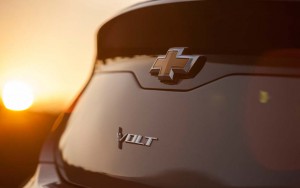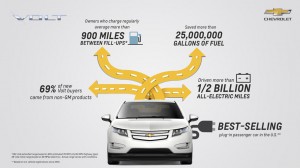
Chevrolet offers a tease of the 2016 Volt plug-in hybrid it will unveil at the next Detroit Auto Show.
General Motors will reveal an “all-new” version of its Chevrolet Volt plug-in hybrid vehicle at the Detroit Auto Show next January, a senior Chevy official confirmed during a speech at an industry confab.
The new model is expected to remain true to its original mission, which is to provide a way for motorists to not only improve their fuel economy but operate entirely on battery power for much of their day-to-day driving.
But there are likely to be significant changes to the next-generation Chevy Volt, nonetheless, and various sources tell TheDetroitBureau.com that the new version will not only get a redesign inside and out, but longer battery range and improvements in performance. Perhaps most importantly, GM will aim to reduce the price of the plug-in hybrid to improve its competitors and reverse weakening demand.
“Volt is the perfect example of the ingenuity that drives everything we do at Chevrolet,” Chevy’s Chief Marketing Officer Tim Mahoney said at the annual Management Briefings Seminar near Traverse City, Michigan. “Volt fully delivers on the promises of Find New Roads and will continue to provide consumers with the transportation solutions they need and deserve in the future.”
(Tesla delivers stronger-than-expected earnings, offers more details on Gigafactory plans. Click Here for the story.)
The executive declined to discuss specific details of the new vehicle, beyond emphasizing it will be “all-new,” a rapid move for a vehicle that came to market only in late 2009. Traditionally, an automaker would only be expected to make a modest, mid-cycle “refresh” at this point.

Despite sluggish sales, Chevy bills the Volt as a success.This infographic shows why. Click to Enlarge.
But the Volt isn’t a traditional automobile. It was the first mainstream product to pair a gasoline engine with a large lithium-ion battery pack and an electric motor. The combination allows a driver to get more than 35 miles in battery-only mode while also significantly boosting fuel economy when Volt operates more like a conventional hybrid.
The first-generation model came out “during a pretty dark time” for GM, less than a year after it emerged from bankruptcy, noted automotive analyst Dave Sullivan, of AutoPacific, Inc. But after an initial burst of positive headlines, it has had a tougher time than GM expected.
Price was a major issue, the Volt initially coming in at over $40,000 – before a motorist applied a federal $7,500 tax credit – well above the price of a similarly sized Chevy Cruze sedan. Performance was also a concern, the Volt needing nearly 10 seconds to launch from 0 to 60. And the unusual, T-shaped battery pack not only added significantly to the weight of the Gen-1 Volt but also bisected the rear seat, limiting capacity to four passengers.
Whatever the reason, while Chevrolet Volt sales did improve by 13% year-over-year in July, they’re down 8.7% for the first seven months of 2014, at just 10,635. Shortly after launch, GM officials had publicly expressed expectations of selling 45,000 plug-in hybrids annually worldwide – a figure including the soon-to-be-dropped European Opel Ampera. They have so far not come close.
Chevy isn’t alone. Despite having the best-selling conventional hybrid on the market, Toyota has received a tepid response to its plug-in version of the Prius, even though it can earn a buyer in envir0-friendly California access to the coveted diamond, or commuter, freeway lanes. Other plug-ins haven’t done much better.
Industry officials insist they’re not surprised, and GM executives have cautioned that they were well aware of the Gen-1 Volt’s limitations. Indeed, they have often stressed that they planned to make substantial improvements in subsequent versions.
While they aren’t saying what they are, inside sources and published reports give a clear sense of what’s coming. As with any “all-new” model, Chevy will give the 2016 Volt a new design. But the big changes will be on the technology side.
“We’ll continue to evolve this car,” said Chevrolet spokesman Mike Albano. “Volt will remain true to its cause and its mission,” he added, cautioning, “Don’t look for anything radical or different in direction. We won’t mess with the formula.”
Well, that isn’t precisely accurate. The maker and its battery partner, South Korea’s LG Chem, have already been tinkering with the formulation of the lithium-ion pack, and the Gen-2 Volt should benefit with a smaller, lighter and more powerful battery that, analyst Sullivan said, could add another 10 to 15 miles in range, even while allowing GM to repackage the pack so that it no longer intrudes into the passenger compartment.
If Volt could yield 50 or more miles on battery power alone it would potentially expand its appeal to those who might otherwise buy a pure battery-electric model, such as the smaller Chevrolet Spark Electric, Nissan Leaf or Ford Focus EV, as the Chevy Volt would retain the added advantage of being able to fire up its internal combustion engine for longer drives.
(Team sets cross-country EV driving record. Click Here to find out what they drove and how they did.)
Volt’s current 4-cylinder “range-extender” gas engine is expected to be changed out, as well. Sullivan and others suggest Chevy will migrate to a new line of smoother, quieter, even more efficient 3-cylinder engine — perhaps using a turbo to boost performance – similar to the 1.0-liter powertrain in the European Opel Adam subcompact.
Volt clearly has to improve itself from a performance, cost and technology standpoint, observers stress, a challenge made even more difficult as conventional gasoline power continues to get better.
(Copenhagen Wheel can make any bike an EV. Click Here to check it out.)

The main range issue is with cold weather performance, same as with fuel economy postings. The 50 mile comment is all well and good, but only if that is under the most extreme circumstances. If that can be achieve during cold weather, with the heater & possbily wipers, lights and intermittent rear defrost, good. Or at the other extreme, AZ, NV, TX, MS, AL, GA and the like in the summer with A/C full tilt, again good. But if that 50 miles is for perfect conditions, like the fine print in those past “gets XYZ mpg (small print highway)” commercials and ads, then not so sure. Many of those high-highway mileage vehicles don’t achieve great city / commuter mpgs.
The primary reason for the Volt and other hybrids is to try and meet the impossible and insane 54.5 mpg CAFE requirement that Obama and the EPA pulled from their orifice. Everyone is going to pay through the nose for this absurd mandate to the tune of thousands more per car, per year price increases.
volt magic numbers
50 mile electric range
5 seats
$28.000 price tag
if it hits all these numbers
then it will be a huge success